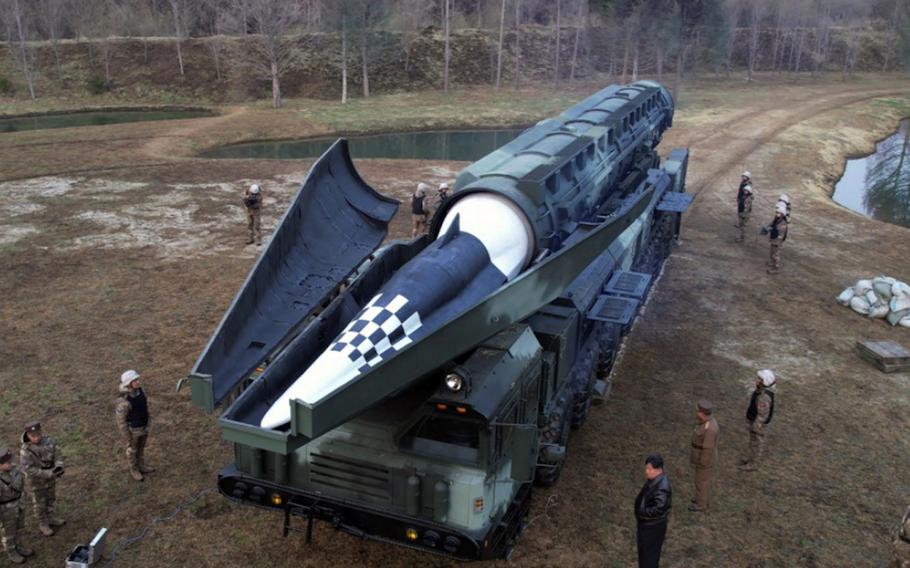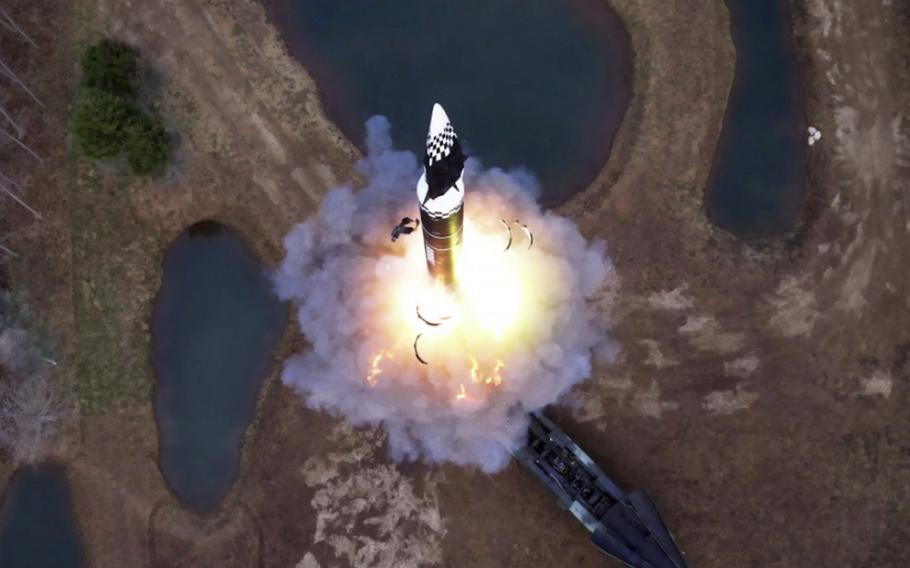
North Korean leader Kim Jong Un, in all black, stands in front of an intermediate-range ballistic missile, April 2, 2024, in this image from the Korean Central News Agency. (KCNA)
CAMP HUMPHREYS, South Korea — North Korea’s test of a hypersonic glide vehicle was unsuccessful this month, but the communist regime is making progress in its development, according to the South’s defense minister.
Mounted on a Hwasong-16B intermediate-range ballistic missile, the vehicle failed during the final glide phase of its April 2 flight, National Defense Minister Shin Won-sik said Sunday on the televised talk show “Sunday Diagnosis.” He cited U.S. and South Korean military assessments of the North Korean test.
Hypersonic weapons travel five times the speed of sound, or more than 3,800 mph, and can maneuver to their target after being released by a booster rocket. Traditional ballistic missiles move at a higher altitude at an arc, making it easier for an opponent to determine their trajectory.
North Korean leader Kim Jong Un oversaw the test, the state-run Korean Central News Agency reported April 3. It said the missile successfully flew about 620 miles.
The weapon could strike any target worldwide “rapidly, accurately and powerfully,” KCNA said.

North Korea fires an intermediate-range ballistic missile, April 2, 2024, in this image from the Korean Central News Agency. (KCNA)
South Korea’s Joint Chiefs of Staff called the North’s specifications “exaggerated” in a message to reporters that day. The solid-fueled ballistic missile flew roughly 370 miles from Pyongyang before falling into the Sea of Japan, or East Sea, they said.
Shin said North Korea has conducted five hypersonic weapons tests since September 2021 and continues to make improvements to its program. The April 2 missile featured ridges, or “wings,” on its warhead while another missile fired Jan. 14 was smooth and cone shaped, he said.
Hypersonic weapons development is a complicated task and will take North Korea some time to master, Shin said.
“But because North Korea is concentrating on it, we believe they will accomplish their goal someday,” he added.
Pyongyang has yet to demonstrate that its hypersonic glide vehicle “could function under realistic conditions” at an intermediate range of around 2,050 miles, the distance to Guam, according to an April 12 report from 38 North, a North Korea-monitoring organization based in Washington, D.C.
Despite the uncertainty in hitting long-range targets, North Korea’s hypersonic weapons “have shown their potential to strike Japan if they are to be used at medium ranges,” the report said.
The U.S. military is developing two hypersonic weapons programs: glide vehicles and cruise missiles that travel at hypersonic speeds, according to a Congressional Research Service report March 22. The Defense Department reportedly requested a $6.9 billion budget for the programs for the next fiscal year.